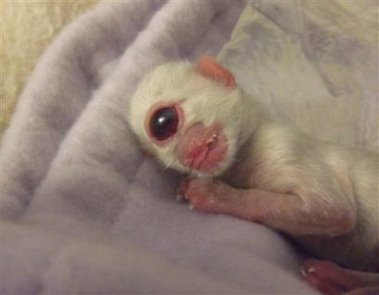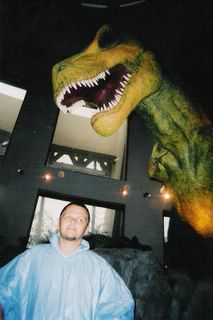'Honey, Warm Up the Cloner!'

Scientists Recover Tissue From T. Rex
from Associated Press
WASHINGTON - For more than a century, the study of dinosaurs has been limited to fossilized bones. Now, researchers have recovered 70-million-year-old soft tissue, including what may be blood vessels and cells, from a Tyrannosaurus rex.
If scientists can isolate proteins from the material, they may be able to learn new details of how dinosaurs lived, said lead researcher Mary Higby Schweitzer of North Carolina State University.
"We're doing a lot of stuff in the lab right now that looks promising," she said in a telephone interview. But, she said, she does not know yet if scientists will be able to isolate dinosaur DNA from the materials.
It was recovered dinosaur DNA — the blueprint for life — that was featured in the fictional recreation of the ancient animals in the book and film Jurassic Park.
The soft tissues were recovered from the thighbone of a T. rex, known as MOR 1125, that was found in a sandstone formation in Montana. The dinosaur was about 18 years old when it died.
The bone was broken when it was removed from the site. Schweitzer and her colleagues then analyzed the material inside the bone.
"The vessels and contents are similar in all respects to blood vessels recovered from ... ostrich bone," they reported in a paper bring published Friday in the journal Science.
Brooks Hanson, a deputy editor of Science, noted that there are few examples of soft tissues, except for leaves or petrified wood, that are preserved as fossils, just as there are few discoveries of insects in amber or humans and mammoths in peat or ice.
Soft tissues are rare in older finds. "That's why in a 70-million-year-old fossil it is so interesting," he said.
John R. Horner of the Museum of the Rockies at Montana State University, said the discovery is "a fantastic specimen," but probably is not unique. Other researchers might find similarly preserved soft tissues if they split open the bones in their collections, said Horner, a co-author of the paper.







 what the Great Conjunction is. 'What's the Great Conjunction?'
what the Great Conjunction is. 'What's the Great Conjunction?' 




 A Is for Androids
A Is for Androids B Is for Boba
B Is for Boba C Is for Calvin
C Is for Calvin D Is for Dragons
D Is for Dragons E Is for Elric
E Is for Elric F Is for Futures
F Is for Futures G Is for Genie
G Is for Genie H Is for Hobbits
H Is for Hobbits I Is for Iceman
I Is for Iceman J Is for Jedi
J Is for Jedi K Is for Kraken
K Is for Kraken





































































0 Comments:
Post a Comment
<< Home